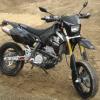
Many new technologies are maturing every year and for motorcyclists, one big change coming is the way we power our bikes…because there’s a new option when picking batteries and it’s called Lithium-iron phosphate.
In this article, we compare & contrast the key differences between the standard, "tried and true" lead acid battery and newer Lithium-iron phosphate units. Hopefully we'll help you answer the question of what's the right battery for your needs and budget. Maybe you already know and we'll just confirm this or possibly challenge some conclusions? ![]()
Click on to the next page to see what we learned...

Next page: How Do They Work?
HOW DO THEY WORK?
We are discussing two types of batteries here, Lead Acid and Lithium-iron phosphate (specifically the Shorai LFX Lithium-iron Battery Series), so let’s take a look at how each one works:
LEAD ACID
Italian physicist Count Alessandro Volta (where the term “Volt” comes from) first created a simple battery from metal plates and brine-soaked cardboard or paper in 1799…and the basic technology hasn’t strayed too far from that original design.
Lead Acid batteries are now manufactured with a hard plastic shell containing small compartments that hold both conductive plates (positive and negative) as well as acid (electrolyte) normally in groups of six. Sometimes these have external packages of electrolyte solution that you add and then charge the battery and some are sealed with the solution already installed.
Simply put, these lead plates are coated with either lead calcium (positive plates) or lead antimony (negative plates) which reacts with the electrolyte solution (normally sulfuric acid) in what’s known as an “electro-chemical reaction” that causes the plates to create electrical energy.
LITHIUM-IRON PHOSPHATE
Lithium-iron phosphate batteries are also manufactured with a plastic shell, but inside it’s quite different than the Lead Acid type. Inside the case, they contain both positive and negative electrodes as well as electrolyte, but the electrolyte normally a non-aqueous chemicals like ethylene carbonates and various lithium salts.
The electrodes are made from different materials. The positive electrodes are generally made from layered oxide or phosphate, while the negative electrodes are generally made from graphite.
Also inside you’ll find a separator which is a sheet of very thin micro perforated plastic and it splits the electrodes while allowing ions to pass through. When this battery type charges, Lithium-ions move through the electrolyte from positive electrode to the negative electrode and during discharge this process is basically reversed.

Next page: How Long Do They Last?
HOW LONG DO THEY LAST?
LEAD ACID
Lead Acid battery life differs due to environmental elements including excessive heat and humidity. Battery industry pundits claim that a lead acid motorcycle battery can last five years if cared for properly and in ideal environmental conditions, but that’s not the real world. With lead acid batteries, letting them lose their charge fully can cause harmful sulfation and the battery may not fully recover.
In our experience, if you are using your motorcycle three to four times per week nine months out of the year, keeping it fully charged and you keep it on a battery tender device in the off-season, you should see battery life of two to three years. Lead Acid batteries favor colder, dryer climates, so riders in areas with this type of weather may see even longer battery lives.
LITHIUM-IRON PHOSPHATE (Shorai LFX)
According to Shorai, their Lithium-iron phosphate batteries do not sulfate while sitting and do not suffer the chemical degradation (sulfation) that is common with lead acid batteries. Conditions that will shorten the Lithium-ion phosphate battery life include batteries sized too small for load conditions/wrong bike and failure to maintain the proper voltage when the battery is not being used.
Lithium-iron phosphate batteries can outperform and outlast traditional lead acid batteries under lab test conditions, with some examples showing the LFX Lithium-iron phosphate battery can provide more than 2000 cycles during 80% DOD (depth of discharge) testing, as opposed to 500-800 cycles for lead acid batteries under the same conditions.
So in theory, the LFX Lithium-iron phosphate battery should last from two to four times longer than the lead acid battery.
Next page: What Is The Required Maintenance?
WHAT IS THE REQUIRED MAINTENANCE?
LEAD ACID
Lead acid batteries don’t like heat, humidity or to be discharged fully…so don’t let them go dead while sitting in your bike in that hot garage.
In fact, letting the voltage drop below 12.4 volts can result in lower battery life in general, so if you aren’t riding, make sure to use a “smart” trickle charger like the units from Battery Tender.
We’ve seen riders “top up” their batteries with spare electrolyte or distilled water. This can help with efficiency and maintaining maximum output but over time using distilled water will just dilute the whole mixture and thereby lose its effectiveness.
Tip: For long term storage of lead acid batteries, we remove the battery from the bike and put it in a cool, dry section of our workshop attached to the battery tending device.
LITHIUM-IRON PHOSPHATE
You can’t “top up” a Lithium-iron phosphate battery with electrolyte so it’s important to monitor the voltage and charge as necessary to keep the resting voltage above 13.1 volts.
While standard lead-acid chargers can be used with most Lithium-iron Phosphate batteries when needed, most manufacturers make a charger that is specifically designed to charge, store and maintain the specific product type used.
Tip: When storing a Lithium-iron phosphate battery, it should be disconnected from the vehicle, fully charged to ~14.4 volts and then it can sit for up to 1 year before recharging. Storing in cool, dry environments is preferred for lithium batteries.
Next Page: Weight Savings and Performance
WEIGHT SAVINGS AND PERFORMANCE
Lithium-iron phosphate batteries have shown the ability to operate at a higher voltage range than the typical lead acid battery during cranking, resulting in quicker start times.
Some Lithium-iron phosphate batteries can be up to 80 percent lighter than their lead acid equivalents. This saves an average of 2-3 lbs. for dirt bikes, 6-8 lbs. for street bikes and 10-20 lbs for touring and cruiser bikes.
The difference in weight was even larger for our Honda XR650L as the recommended Shorai LFX19A4-BS12 battery (2.31lbs) is lighter than the lead-acid Yuasa YTZX9-BS (5.4lbs) specified for the bike by a whopping 3.1lbs…that’s huge.
We all know that weight savings is the Holy Grail when it comes to high performance motorcycles and many riders spend thousands on lightweight components like titanium fasteners and carbon fiber bits for their bikes, but it takes a lot of expensive lightweight parts to add up to the weight savings stated when using a Lithium-iron phosphate battery and we consider this to be one of the best (and most inexpensive) ways to reduce weight on your motorcycle.
These Lithium-iron phosphate batteries are surprisingly much smaller than their lead acid equivalents, and this caused some dismay when they were first released and the battery was loose in the battery tray/carriers on some bikes…but now many manufacturers include some adhesive-backed foam padding to take up the excess room.

Next Page: Environmental And Temperature Considerations
ENVIRONMENTAL AND TEMPERATURE CONSIDERATIONS
Typical lead acid batteries quote their normal operating range as 14 -140 F while Lithium-iron phosphate units quote this range as 20 -140 F, so not a huge difference there, but what happens when temperatures drop below the recommended range?
LEAD ACID
When a lead acid battery is used below 14 degrees F, the battery’s ability to discharge current will decrease because low temperatures slow down the chemical reaction inside. Lower cranking amperage means less power to turn over your engine, which can be even harder to crank than in normal temperatures, due to thicker oil viscosity depending on oil type and grade used.
This phenomenon can be compensated with somewhat by using a battery with the highest CCA (Cold Cranking Amps) and AHr (Ampere-Hour) rating correct for your application, because under actual cranking conditions they will deliver considerably less than specified capacity.
Why? Because lead acid begin sulfating when only a small percentage of the capacity has been used, and their internal resistance rises as they are discharged, the actual capacity which can be used may be as little as 20% of the printed rating.
LITHIUM-IRON PHOSPHATE
At lower temperatures the output of the Lithium-iron phosphate battery is also adversely affected and it’s recommended that battery is fully charged after storage to improve performance in cold weather.
The good news is that Lithium-iron phosphate battery cells are capable of 80% discharge without damage and while retaining higher cranking output. As such, the actual usable capacity can be on par with 18AHr-rated lead acid batteries while providing higher cranking performance and a reduction in weight.
There is a recommended procedure that can help compensate for the cold weather reduction in performance when using a Lithium-iron phosphate battery:
Turn on your headlight because it helps output for the battery to flow some current before cranking in cold weather. The suggested headlight-on time before cranking depends on the temperature. If starting at 40F/5C, 30 seconds will help wake the battery and increase cranking performance. If at 0F/-17C, leave the lights on for 4-5 minutes before cranking and thee result will be a better first crank and longer battery life.
If the engine fails to start on first crank, that first crank has warmed the battery, and the second attempt will be much stronger. Other accessories that can be turned on before cranking can also be used for this purpose, such as heated gear, GPS, etc.
Next Page: How Much Do They Cost?
HOW MUCH DO THEY COST?
We priced two batteries for our 2015 Honda XR650L - the Yuasa lead acid unit with 135 CCA was $92, while the Lithium-iron phosphate battery with 285 CCA’s was $189, so you’re paying for the higher cranking performance (almost double the CCA’s) as well as much lighter weight.

Next Page: What Did We Conclude?
SUMMARY AND CONCLUSION
Although Lithium-iron phosphate battery technology is fairly new, it has significant benefits and few drawbacks at this point in its development.
Advantages of the Lithium-iron phosphate batteries include dramatically lighter weight, higher cranking amperage ratings per size of the unit, intelligent charging mechanisms and much less chance of corrosive material spillage.
The one disadvantage in this author’s mind would be the increased cost.
In conclusion, yes, we believe that Lithium-iron Phosphate battery technology is, except for cost considerations, “better” than the standard lead-acid battery and will be the Grim Reaper that makes lead-acid batteries obsolete as we move forward in time.
Have a burning question ![]() or need to inform us that we've missed something?
or need to inform us that we've missed something? ![]() Hit us up in the comment section below. We want to hear your thoughts & experiences on this topic!
Hit us up in the comment section below. We want to hear your thoughts & experiences on this topic!







Recommended Comments